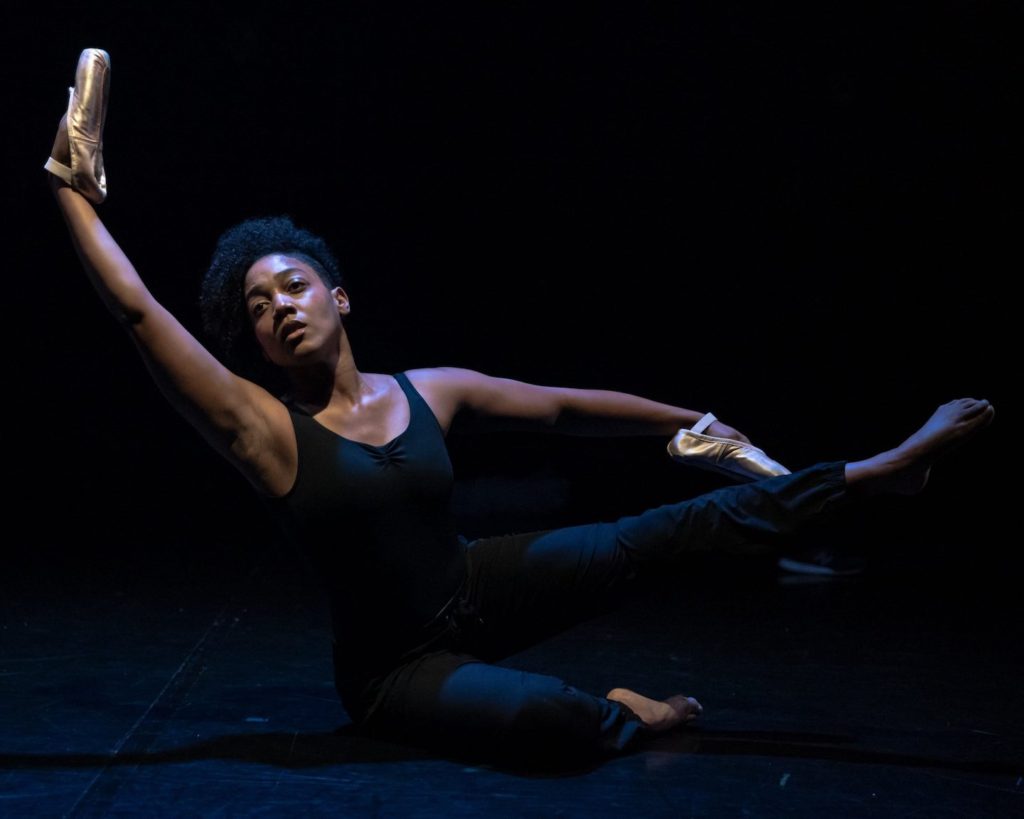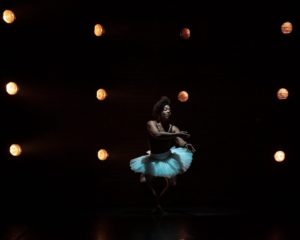Black Ballerina: Syreeta Hector’s memoir in motion - Vancouver Ballet Society
- Home
- Features 2020 - 2023
- Black Ballerina: Syreeta Hector’s memoir in motion

By Kathleen Smith
For dancer/choreographer Syreeta Hector, the solo work Black Ballerina is the distillation of years-long personal research into identity, family history and how to be an artist in a society that tends to tamp down both.
Created largely pre-pandemic, and two years in the making, Black Ballerina poetically gathers the threads of Hector’s diverse cultural and artistic influences into a free-flowing collage of sound and movement imagery. Hector — a New Brunswick-born artist who is of Mi’kmaq, African American and Acadian heritage — was a member of Toronto Dance Theatre, a contemporary company, from 2009 to 2014. But Black Ballerina also reflects on Hector’s complicated relationship with classical ballet, a form that is not always welcoming to dancers that look like her.

“As a performer I’ve always loved the beautiful sense of athleticism and calmness of classical ballet,” she says. “But, in high school, I was told I’d never be a ballet dancer so I shouldn’t audition for ballet intensives. Never did I think that being a ballerina was realistically achievable for me.”
Skin colour, body type, height — keeping dancers out based on physical qualities has always been part of ballet’s elitism. Hector believes that not much has changed over the years, even when it comes to race. “Sometimes I think about the Misty Copelands and this new surge of diverse ballet — you know, ‘Look here, we made the pointe shoes match the colour of the dancer’s skin.’ This feels very late to me; we should be well past that.”
Hector found another way into ballet as an educator. “I always knew that I wanted to teach dance. There’s a fantastic teacher in New Brunswick who went to Canada’s National Ballet School [NBS] for teaching: Andrea Scott. Studying with her was confirmation that their Teacher Training Program was the one I wanted to go through. When I moved to Toronto, I went to the NBS program, which involved working with the students in their professional and recreational programs.”

Hector now teaches dance technique at both Ryerson and York Universities in addition to making her own work and dancing for other choreographers, most recently, Peggy Baker. Hector is featured in Baker’s ensemble work, her body as words; cancelled last March because of the pandemic, the piece is being re-imagined as a film directed by Jeremy Mimnagh.
Hector says it’s taken a long time to reach the point where she feels safe enough to speak and make work about some of the ideas embedded in Black Ballerina. “I think that for a lot of my life I avoided my identity,” Hector says. “But it’s not just me — it’s the way that systemic racism happens. We are taught to forget who we are and where we are from, or we’re asked to not discuss it. I’ve had time now to reflect on my experiences and am at the point in my career where I don’t feel like I’m going to get in trouble.”
Speaking up in this manner with art, pushing back against the gate-keeping mechanisms that keep artists down, is more resonant than ever with audiences, and Hector’s 40-minute solo has been iterating all over the place — from live performances in Europe and at Toronto’s Summerworks Festival in 2019 to an ambitious 49-minutee livestream version directed by Barbara Willis Sweete that inaugurated the Citadel Live series in November 2020. Now, the work is once again in the public eye at Harbourfront Centre’s Kuumba Festival in celebration of Black History Month. From February 14-21, Kuumba will show a re-stream of Hector and Willis Sweete’s version from the Citadel.
“Initially, I was hesitant to livestream Black Ballerina,” Hector says. “But when it turned out we wouldn’t be able to go back into theatres any time soon, I began to consider the possibilities.” When Willis Sweete, an experienced director with a special sensitivity to opera and dance, came on board, Hector felt fully supported reimagining the solo for a complicated live video shoot with four cameras and full crew.
It’s a poignant fact that, as the pandemic continues, it may be some time before Black Ballerina is once again performed live. Although she is fully committed to the live aspect of performance in her work, Hector is nothing if not practical.
“Like many artists I really struggled when the lockdown started. There was this low point, when I thought to myself, I can’t rehearse Black Ballerina just anywhere, I just can’t.’ But what was I going to do about it? By the summer I thought, ‘I have to go back to who I am — I have to dance.’ I found this storage container online — so now I have a small studio on my condo patio where I can teach online and practice. These creative ways that we’ve been forced into in this pandemic period, sometimes they’re pretty magical.”
In the closing moments of Black Ballerina, Hector dons a tutu and dances under a snowfall of talcum powder that clings to her dark skin. It’s a powerful image, calm and eerie as Hector uses classical technique to gently prod one last time at one of her central questions: “What are the different identities we take on in a day and what does it all mean?”

